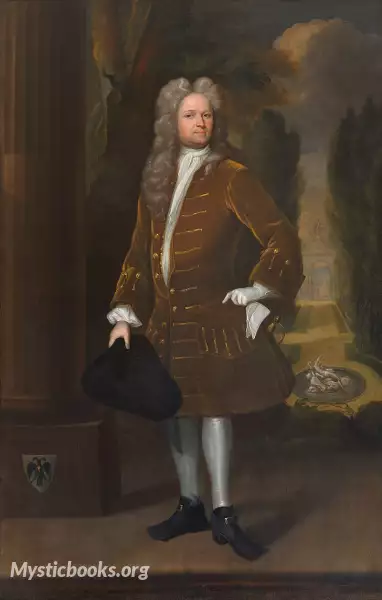
Timeline
Title
Country/Nationality
William Stukeley
William Stukeley was an English antiquarian, physician and Anglican clergyman. A significant influence on the later development of archaeology, he pioneered the scholarly investigation of the prehistoric monuments of Stonehenge and Avebury in Wiltshire. He published over twenty books on archaeology and other subjects during his lifetime.
Born in Holbeach, Lincolnshire, as the son of a lawyer, Stukeley worked in his father's law business before attending Bene't College, Cambridge. In 1709 he began studying medicine at St Thomas' Hospital, Southwark, before working as a general practitioner in Boston, Lincolnshire. From 1710 till 1725 he embarked on annual tours of the countryside, seeking out archaeological monuments and other features that interested him; he wrote up and published several accounts of his travels. In 1717, he returned to London and established himself within the city's antiquarian circles. In 1718 he was elected a Fellow of the Royal Society and became the first secretary of the Society of Antiquaries of London. In 1721 he became a Freemason and in 1722 co-founded the Society of Roman Knights, an organisation devoted to the study of Roman Britain. In the early 1720s, Stukeley developed a particular interest in Stonehenge and Avebury, two prehistoric stone circles in Wiltshire. He visited them repeatedly, undertaking fieldwork to determine their dimensions.
Stukeley was born on 7 November 1669 in his parental home in Holbeach, Lincolnshire. He was the eldest child in a family of four boys and one girl; it is possible that he was named after William of Orange, who soon after became King of England. His paternal grandfather, John Stukeley (1623–1675), was a country gentleman who possessed a small estate at Uffington, Lincolnshire and who accrued a large number of debts by the time of his death. John had two sons; the elder, Adlard, was apprenticed to the legal profession, while the younger, also called John, was initially trained as a farmer before joining Adlard in a family law firm. On 28 May 1686, John married the teenage daughter of Robert Bullen in Pinchbeck, Lincolnshire; their first child was miscarried, with William being their second.
In 1692, at the age of five, Stukeley began an education at Holbeach's Free School, where he learned to read and write. By the age of thirteen, he was the top-rated pupil at his school. As a schoolchild, he began collecting Roman coins after a hoard was found nearby and also developed interests in botany and medicine. In 1700, he was taken out of school to work in his father's legal business. With his father he travelled south to London on various occasions, where he purchased many books and scientific instruments. He was nevertheless bored by his law activities, and when he requested that he be allowed to study at university, his father agreed.
Piggott described Stukeley as "a gregarious creature" who enjoyed conversation and being flattered. Haycock referred to Stukeley's "amiable personality", while Piggott also highlighted "an immensely likeable quality" to Stukeley's personality, as evidence highlighting that when the reverend was laid up in bed in Queens Square on one occasion, over 120 friends and parishioners either visited him or sent him a message of sympathy. He also regarded the antiquary as displaying a "charm and pleasant oddness" as well as a "cheerfulness and disarming ingenuousness". Piggott also noted that in later life, Stukeley became "self-opinionated" and "dogmatic".
After the antiquarian's death, Bishop Warburton stated that in Stukeley displayed "a mixture of simplicity, drollery, absurdity, ingenuity, superstition and antiquarianism, that he afforded me that kind of well-seasoned repast, which the French call an Ambigu, I suppose from a compound of things never meant to meet together."
According to Hutton, Stukeley had "a profound and lifelong love of structure, form and design" that was reflected in his interest in the medieval profession as well as antiquities. He had an enthusiasm for gardening, and was fond of both city and countryside, enjoying the ability of traveling between the two. Fond of pets, he reported feeling great grief following the death of his cat, Tit, in the 1740s. While living in Boston, he aligned himself with the Tories. He suffered from gout, having his first attack of the disease in 1709.
Stukeley's decision, in 1722, to adopt the pseudonym of Chyndonax reflected his inclinations towards identifying with the druids in a personal capacity. This was bolstered by the tendency of friends in the Society of Roman Knights to refer to him, both in conversation and correspondence, as "the Druid".
By 1740, he was beginning to depict the stone circles at Avebury—which are perfectly circular—as ovals in his illustrations so that they better fitted the shape of a serpent's head, which he believed they symbolised.
Books by William Stukeley

Stonehenge, a Temple Restor'd to the British Druids
Stonehenge in Wiltshire, England never fails to amaze and fascinate; and has been the subject of speculation, research and investigation for centuries. This is an early look at this enigmatic location. As the author says in the preface: "A few years...